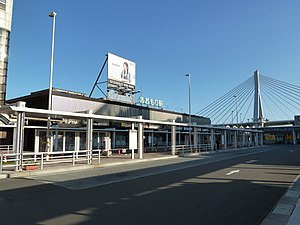Aomori Station
Aomori Station 青森駅 | ||||||||||||||||||||||||||||||||||||
|---|---|---|---|---|---|---|---|---|---|---|---|---|---|---|---|---|---|---|---|---|---|---|---|---|---|---|---|---|---|---|---|---|---|---|---|---|
 Aomori Station entrance in August 2011 | ||||||||||||||||||||||||||||||||||||
| General information | ||||||||||||||||||||||||||||||||||||
| Location | 1 Yanagawa, Aomori-shi, Aomori-ken Japan | |||||||||||||||||||||||||||||||||||
| Coordinates | 40°49′43.87″N 140°44′4.89″E / 40.8288528°N 140.7346917°E | |||||||||||||||||||||||||||||||||||
| Operated by | ||||||||||||||||||||||||||||||||||||
| Line(s) | ||||||||||||||||||||||||||||||||||||
| Platforms | 3 island platforms | |||||||||||||||||||||||||||||||||||
| Connections | Bus terminal | |||||||||||||||||||||||||||||||||||
| Other information | ||||||||||||||||||||||||||||||||||||
| Status | Staffed ("Midori no Madoguchi") | |||||||||||||||||||||||||||||||||||
| History | ||||||||||||||||||||||||||||||||||||
| Opened | 1 September 1891 | |||||||||||||||||||||||||||||||||||
| Passengers | ||||||||||||||||||||||||||||||||||||
| FY2016 | JR East: 5,342 (daily) | |||||||||||||||||||||||||||||||||||
| Services | ||||||||||||||||||||||||||||||||||||
| ||||||||||||||||||||||||||||||||||||
| ||||||||||||||||||||||||||||||||||||
Aomori Station (青森駅, Aomori-eki) is a railway station in the city of Aomori, Aomori Prefecture, Japan, jointly operated by East Japan Railway Company (JR East) and the third-sector railway operator Aoimori Railway.
Lines

Aomori Station is served by the following lines:
- Ōu Main Line (for Shin-Aomori, Hirosaki, Akita, Yamagata, and Niigata)
- Tsugaru Line (for Kanita and Minmaya)
- Aoimori Railway Line (for Hachinohe and Morioka)
The Tsugaru-Kaikyō Line formerly served Aomori Station as a connection to Hakodate in Hokkaido via the Seikan Tunnel. However, with the opening of the Hokkaido Shinkansen, conventional rail passenger services between Aomori and Hakodate have since been discontinued.
Station layout
Aomori Station has three island platforms connected to the station building by a footbridge. The station has a "Midori no Madoguchi" staffed ticket office and a View Plaza travel agency.
Platforms
| 1 | ■ Aoimori Railway Line | for Asamushi-Onsen, Noheji, and Hachinohe for Shimokita and Ōminato |
| 2 | ■ Aoimori Railway Line | for Asamushi-Onsen, Noheji, and Hachinohe for Shimokita and Ōminato |
| ■ Ōu Main Line | for Shin-Aomori, Hirosaki, Ōdate, and Akita | |
| 3 | ■ Ōu Main Line | for Shin-Aomori, Hirosaki, Odate, and Akita |
| ■ Tsugaru Line | for Kanita and Minmaya |
Super-Hakuchō and Hakuchō services usually reverse through the Ōu Main Line to terminate at Shin-Aomori.
Limited express train services
The following Limited express services stop at Aomori Station:
- Tsugaru (Akita - Aomori)
Former services
The following Limited express services used to stop at Aomori Station:
- Hakuchō / Super Hakuchō (Shin-Aomori - Hakodate via Aomori)
The following overnight sleeping car services also used to operate to and from Aomori Station.
History
The station opened on 1 September 1891.[1] With the privatization of Japanese National Railways (JNR) on 1 April 1987, the station came under the control of JR East.[1]
Surrounding area

- Aomori Bay Bridge
- Aomori Station building "Lovina"
- A-Factory
- Station square building "Auga"
- Aomori Citizens Library
- Aomori station square police box
- Nebuta Museum Wa Rasse
- JR Bus Tohoku Aomori office
- Odashima Building
- Towada Kanko Bus Aomori ticket counter ("Blue city" ticket)
- Aomori Prefectural Office
- Aomori City Hall
Buses
Buses serving the station are operated by the following operators.
- Aomori City Bus
- Kōnan Bus Company
- JR Bus Tohoku Company
- Towada-Kanko Electric Railway
- Shimokita Kotsu
Highway buses
- Asunaro; For Namioka, Kuroishi, Kosaka, and Morioka Station[2]
- Blue City; For Sendai Station[3]
- Sky; For Ueno Station[4]
- Panda; For Ueno Station[5]
- Enburi; For Shinjuku Station and Tokyo Station[6]
- Tsugaru; For Shinjuku Station and Tokyo Station[7]
- La Foret; For Tokyo Station[8]
Passenger statistics
In fiscal 2016, the JR East portion of the station was used by an average of 5,342 passengers daily (boarding passengers only).[9]
See also
References
- ^ a b Ishino, Tetsu, ed. (1998). 停車場変遷大辞典 国鉄・JR編 [Station Transition Directory - JNR/JR]. Vol. II. Japan: JTB. p. 420. ISBN 4-533-02980-9.
- ^ "あすなろ号 - 弘南バス株式会社". www.konanbus.com. Retrieved 2016-02-05.
- ^ "ブルーシティ号 - 弘南バス株式会社". www.konanbus.com. Retrieved 2016-02-05.
- ^ "スカイ号 - 弘南バス株式会社". www.konanbus.com. Retrieved 2016-02-05.
- ^ "パンダ号 - 弘南バス株式会社". www.konanbus.com. Retrieved 2016-02-05.
- ^ "えんぶり号 - 弘南バス株式会社". www.konanbus.com. Retrieved 2016-02-05.
- ^ "津輕号 - 弘南バス株式会社". www.konanbus.com. Retrieved 2016-02-05.
- ^ "青森-東京(ラ・フォーレ号) 予約制 | 高速バス | JRバス東北【公式HP】|高速バス 仙台-新宿 3列シート車3000円~". www.jrbustohoku.co.jp. Retrieved 2016-02-05.
- ^ 各駅の乗車人員 (2016年度) [Station passenger figures (Fiscal 2016)] (in Japanese). Japan: East Japan Railway Company. 2017. Retrieved 11 January 2018.
External links
- JR East station information (in Japanese)
- Aoimori Railway station information (in Japanese)


